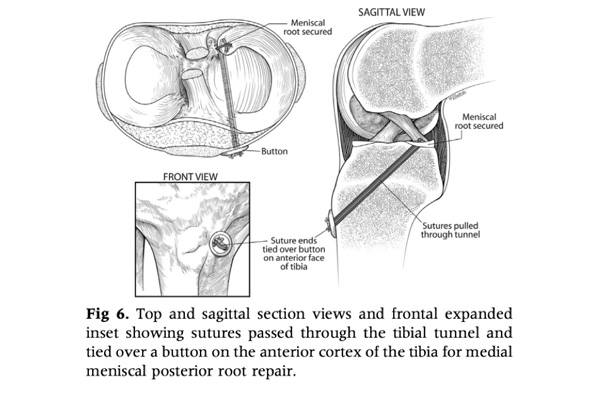
A meniscus root tear can be a challenging injury, but advances in surgical techniques like meniscus root repair have made it possible for athletes and active individuals to return to high levels of activity. However, the success of the surgery is only half the story—a well-structured rehabilitation program is essential to achieving optimal outcomes. In this blog, we’ll break down the key phases of rehab after a meniscus root repair and highlight important considerations along the way.
Understanding Meniscus Root Repair
The meniscus is a crescent-shaped cartilage that acts as a shock absorber in the knee, protecting the joint during movement. A root tear occurs at the attachment point of the meniscus, leading to instability and increased stress on the cartilage. Meniscus root repair aims to reattach the meniscus to its bony anchor, restoring its function and preventing further damage to the knee joint.
Rehabilitation following a meniscus root repair is unique because it requires a careful balance between protecting the repair and gradually restoring strength and mobility.
Key Phases of Rehab
Phase 1: Protection and Healing (Weeks 0-6)
The primary goal in this phase is to protect the surgical repair and allow the meniscus to heal.
-
Weight Bearing: Most patients will be non-weight-bearing using crutches for 4-6 weeks to avoid stressing the repair site (MD will specify time)
-
Range of Motion (ROM): Limited ROM exercises are introduced, often restricted to 0-90 degrees, to prevent excessive strain on the meniscus root.
-
Exercises: Isometric quadriceps contractions, straight-leg raises, and gentle patellar mobilizations are common to maintain muscle activation and reduce stiffness.
-
Key Tip: Follow your surgeon’s guidelines strictly, as overloading the knee too early can jeopardize the repair.
Phase 2: Gradual Loading and Mobility (Weeks 6-12)
Once the initial healing has occurred, the focus shifts to gradually increasing knee mobility and strength.
-
Weight Bearing: Transition to full weight-bearing as tolerated, often with guidance from a physical therapist.
-
ROM: Progression to full ROM is typically encouraged during this phase.
-
Strengthening: Begin closed-chain exercises like mini-squats and leg presses, avoiding deep flexion that could stress the meniscus.
-
Balance and Proprioception: Exercises to improve stability and coordination, such as single-leg stands, are introduced.
Phase 3: Strength and Functional Training (Weeks 12-24)
The goal is to rebuild strength and prepare for a return to functional activities.
-
Strengthening: Focus on lower-body strengthening with progressive resistance training, including hamstrings, quadriceps, and gluteal muscles.
-
Low-Impact Cardio: Activities like cycling or swimming are incorporated to improve cardiovascular fitness without stressing the knee.
-
Functional Movements: Gradual reintroduction of sport-specific drills or activities begins during this phase under professional supervision.
-
Key Tip: Avoid high-impact activities like running or jumping until cleared by your surgeon or physical therapist.
Phase 4: Return to Sport or Activity (Months 6-9)
This phase emphasizes the safe transition back to full activity.
-
Plyometrics and Agility: Gradually reintroduce high-impact movements and dynamic exercises.
-
Sport-Specific Drills: Tailor exercises to mimic the demands of your sport or activity.
-
Mental Readiness: Address any fear of reinjury through mental resilience training and visualization techniques.
Important Considerations
-
Consistency is Key: Adhering to your rehab plan and attending physical therapy sessions regularly will ensure steady progress.
-
Communication: Keep an open dialogue with your surgeon and physical therapist to address any concerns or setbacks.
-
Patience: Recovery from a meniscus root repair can take 6-12 months. Rushing the process increases the risk of reinjury or complications.
-
Focus on Quality: Proper form during exercises is critical to avoid compensatory movements that could harm other parts of your body.
Rehabilitation after a meniscus root repair is a marathon, not a sprint. By following a structured plan and maintaining a positive mindset, you can rebuild strength, restore mobility, and return to the activities you love. With patience and perseverance, your knee can become stronger and more resilient than ever.






